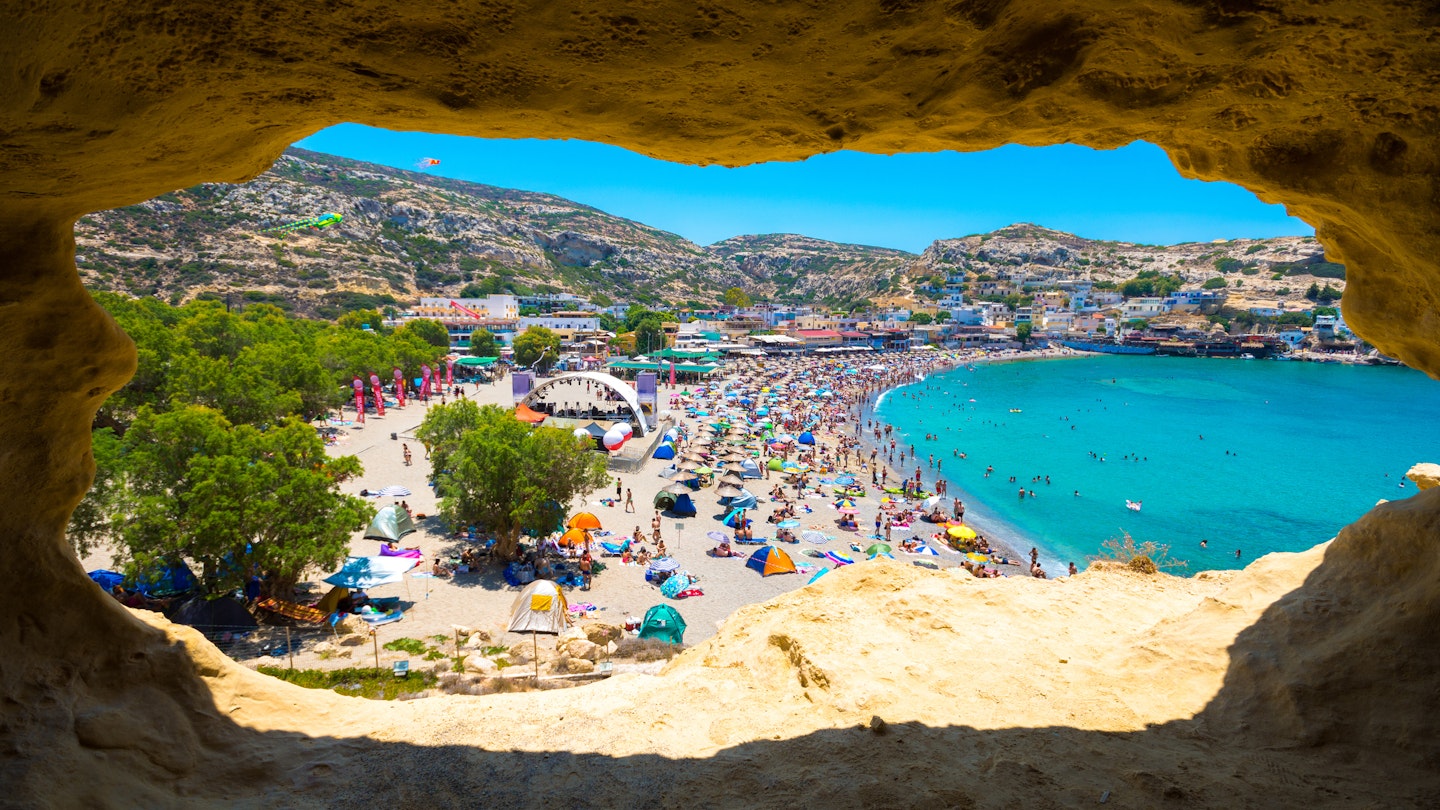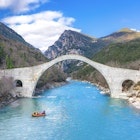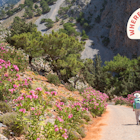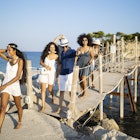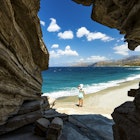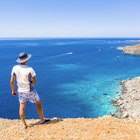If your image of Crete is beaches lined with sweaty bodies roasting during long days of blasting sunshine, well you've got summer correct. But the island is seasonal, and in winter it can get cold, windy and wet.
Sights and businesses set their schedule to the tourist season. While summer sees endless festivals and people enjoying long nights on taverna terraces, by winter, much of the island is closed, with residents hunkered down indoors. In shoulder season, when things are open, temperatures are mild and crowds are moderate. This can be an ideal time to visit Crete.
Join the masses reveling in high-season heat during July and August
Everything is open in high season and there are non-stop parties wherever visitors gather. The temps are sweaty but the Med offers temperate relief. Book everything far in advance as flights and hotels fill up quickly.
Average summertime highs are 29ºC (84ºF), with higher temps on the beaches and hillside trails. Rain is rare.
Crete is open and uncrowded in shoulder season (April to June, September and October)
Most businesses and attractions are open, which means you can rent a beach umbrella, enjoy a seaside taverna lunch and visit a remote church on a mountain pass. Prices are moderate and the availability of flights and rooms is good. You may even find last-minute deals.
Average daytime highs range from 20ºC to 27ºC (68ºF to 80ºF) depending on your proximity to summer. Most days have less than a 10% chance of rain.

Have the beaches to yourself during the low season of November to March
Because almost every tourist-focused business is closed, a lack of visitors also means there is a lack of available places to stay. Still, people ready to explore wintertime Crete, when the waves pound desolate beaches and most Cretans prefer the comforts of a well-stoked fire, will find rooms for rent in larger towns and cities. And note: the world-class ruins at Knossos are open year-round.
Average temps during the short days of weak sunlight hover around 15ºC (59ºF), and storms off the Med can drop large amounts of rain and blow chilly winds for days on end.
January is the month for museums and churches
Few visitors ply the winding roads of Crete during January when the tallest peaks are often capped with snow. It's cold so bundle up for bracing walks on the deserted beaches and seek out warmth and intellectual stimulation in museums and churches. The big days for Cretan families are New Year's Day when people eat vasilopita (golden glazed cake) and January 6, the day of the Epiphany when priests bless the waters.
Key events: New Year's Day (Feast of St Basil), Epiphany (Blessing of the Waters).
February equals fun, from country hikes to Carnival
The brisk temps continue into February, although hillsides show flashes of green and speckles of color from the very first wildflowers. Families venture out for walks in the hills, especially on the first Monday of Lent. Life in towns and cities is punctuated by Carnival, a thrilling three-week pre-Lenten celebration featuring masquerade balls, street parties, treasure hunts and more. The final Sunday sees spectacular parades that devolve into mass frivolity. Rethymno has the wildest scene.
Key events: Carnival, Shrove Monday.
March is great for venturing outside
While only the hardiest are plunging into the still-chilly Med, crystal-clear days and moderating temps mean that the island is open for exploration. Find a trail to the remotest beach or the loftiest peak and revel in the springtime freshness. March 25 is a major holiday when local life shuts down and people celebrate the Feast of the Annunciation when Mary found she was pregnant. On the same day parades wind through the streets for the second month in a row as Greeks celebrate Independence Day.
Key events: Feast of the Annunciation and Independence Day, both on March 25.

April features joyous Easter festivities
Orthodox Easter, which occurs on a changing date that's different from Catholic Easter, is the most important religious date in a nation that takes its religious dates very seriously. Good Friday features massive processions, often accompanied by a blessing of the boats in coastal towns. At midnight on Easter Saturday, fireworks light up the sky in every town, large and small. This is followed by a late-night feast of roast lamb and other iconic Greek dishes. In Crete, residents love to invite visitors to join the celebrations.
Key event: Orthodox Easter.
May brings picnics and adventures outdoors
Beachside tavernas, cafes and clubs begin opening right after Orthodox Easter. This is one of the best months to visit Crete as prices are still moderate as are the crowds. On May Day, the hills come alive with families and groups out hiking. The air is redolent with the verdant spring scents of sage, thyme, rosemary and other wild herbs. Wildflowers are made into wreaths that decorate houses. Head to Hania for the largest of the island-wide celebrations of the Battle of Crete, the epic WWII struggle against the Nazis.
Key events: May Day, Battle of Crete Anniversary.
June means summer is here
Hit the beaches, which are now fully open. The water is rapidly warming and businesses still have a gloss from winter renovations. In Hania, Rethymno and Iraklio, look for special exhibits in galleries and music festivals large and small. Markets burst with local produce, where everything seems to be in season at once. Navy Week gives port towns a chance to celebrate sailors, boats and the sea.
Key event: Navy Week.

July is the start of peak season
Crete is hot, from the beaches to the mountainsides. At night the temps may be moderate but not the energy – peak season means that every top taverna and club is heaving. Be sure to book your favorite places for dinner. Relive the Renaissance at a huge cultural festival in Rethymno; in Iraklio, the Summer Arts Festival runs to mid-September and features top classical music, dance, art, films and more.
Key events: Renaissance Festival, Iraklio Summer Arts Festival.
August is the hottest month
Festivals large and small are held across Crete. It seems like every town, no matter how tiny, plans something special during August. But everything comes to a halt on August 15 for the Feast of the Assumption, the day Mary ascended to heaven. Families reunite, the roads are clogged and businesses close. Otherwise, this is the month to dunk your sweaty self in the temperate waters of the Med.
Key event: Feast of the Assumption.
September is still hot but with fewer crowds
After August, Crete's crowds rapidly diminish and the vibe becomes older and more mature as children and young adults head back to school. But the temps are still hot by day and balmy by night. This is an excellent time to hit the beaches, as they're uncrowded, yet the tavernas are still open and the water is bathtub-warm.
Key event: Feast of Agios Stavros
October is good for mellow explorations
Shutters begin coming down on beach businesses and the island's focus moves on from tourism. Yet the weather remains delightful, most churches and museums are open, and you can hit the hiking trails with less worry about heat stroke. Another WWII event is celebrated with parades on October 28, Greece's Ohi (no) Day, when Mussolini was told his troops couldn't pass through Greece.
Key event: Ohi Day.
November brings fresh raki
After the fall grape harvest is pressed for wine, the leftover mush is fermented and turned into raki, the national drink of Crete. A symbol of friendship and hospitality, the clear and highly alcoholic drink is served on almost any occasion. To welcome people into your home and not serve raki is unthinkable. Fresh batches issue forth from producers large and small all month. An ample excuse to tip back a glass – as if any is needed – occurs during the Moni Arkadiou Anniversary, which is celebrated from November 7 to 9. It recalls the time in 1866 when Cretan defenders blew themselves up, taking many Turk invaders with them.
Key event: Moni Arkadiou Anniversary.
December is a good time put another log on the fire
Almost every tourist business is closed by December and the focus on Crete turns to families and Christmas. Temperatures fall, along with snow in the mountains. Fires are kept burning on hearths and heavy wool sweaters are retrieved from storage. Although Western commercialism has brought seasonal icons like Santa Claus and Christmas trees, in some seaside villages the holiday is still honored in the traditional way, by decorating fishing boats.
Key event: Christmas.
